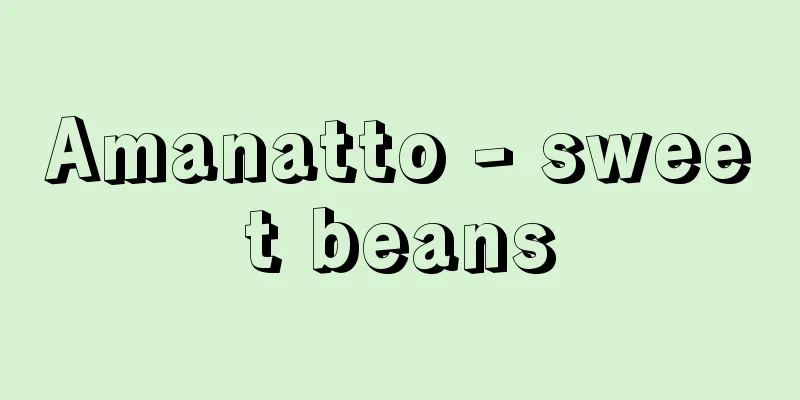Amanatto - sweet beans

|
In terms of the classification of sweets, it is a type of candied bean snack. There is a theory that it existed in the late Edo period (Japanese Food Encyclopedia), and another that it was created in the early Meiji period by Hosota Yasubei of Eitaro, a confectionery store in Nishikawashi, Nihonbashi, Tokyo (Daigenkai). Meanwhile, the 1908 entry in the Meiji Tokyo Anbunshi introduces the Japanese Encyclopedia, published in November, as explaining that "amanatto has been produced in Tokyo in recent years." Even if it existed in the late Edo period, it is unlikely that there were any good quality products. All theories agree that the name amanatto was an allusion to the Enshu specialty Hama natto (short for Hamana natto, natto made at Daifukuji Temple on the shores of Lake Hamana in Shizuoka Prefecture, now Mikkabi-cho, Kita-ku, Hamamatsu City). Amanatto, which was created based on the shape of Hama-natto, was originally made primarily with adzuki beans and cowpeas, but now the ingredients have been expanded to include peas, broad beans, kidney beans (middle beans, golden beans), and even chestnuts. It is made by soaking these beans or peeled chestnuts in honey, then carefully boiling it down and coating it with white sugar. When making it, the scum from the ingredients is thoroughly removed, and the beans are boiled without breaking their skins. The product must be neither sticky nor sticky, nor too moist. [Fumio Sawa] [Reference] | |Clockwise from the left in the foreground: adzuki beans, white kidney beans, red kidney beans, and warbler beans ©Shogakukan Sweetened beans ©Shogakukan "> Amanatto (peanuts) Source: Shogakukan Encyclopedia Nipponica About Encyclopedia Nipponica Information | Legend |
|
菓子の分類からいえば砂糖漬けに入る豆菓子の一種。江戸時代末期には存在したという説(日本食品事典)と、明治初年、東京・日本橋西河岸の菓子商栄太楼(えいたろう)の細田安兵衛の創製という説(大言海)がある。一方『明治東京逸聞史』明治41年(1908)の項では、11月に発刊された『日本百科大辞典』が甘納豆について、「東京で、近年甘納豆を製(つく)り出した」と説明していることを紹介している。江戸末期にあったとしても良品はなかったと思われる。甘納豆の名称は、遠州名物浜納豆(浜名納豆の略。静岡県浜名湖畔、現在の浜松市北区三ヶ日(みっかび)町の大福寺でつくられた納豆)になぞらえたものとする見方は各説とも一致している。浜納豆の形状を元にしてつくられた甘納豆も、当初はアズキ、ササゲが主流であったが、いまでは素材を広げて、エンドウ、ソラマメ、インゲンマメ(ウズラマメ、キントキマメ)のほか、栗(くり)甘納豆もつくられている。製造法は、これらの豆類や、むき栗を蜜漬(みつづ)けにしたのち、丹念に煮詰めて白砂糖をまぶす。製造に際しては、十分に素材のあくを取り除き、豆の皮が破れないように煮る。製品はべとつかず、しかも適当にしっとりしていなければ良品ではない。 [沢 史生] [参照項目] | |手前左から時計回りに、小豆、白花豆、金時豆、鶯豆©Shogakukan"> 甘納豆 ©Shogakukan"> 甘納豆(ラッカセイ) 出典 小学館 日本大百科全書(ニッポニカ)日本大百科全書(ニッポニカ)について 情報 | 凡例 |
>>: Amana (sweet lettuce) - Amana (English spelling) Amana edulis
Recommend
Akabi - Akabi
...The idea of abstaining from childbirth as im...
Square (carved ruler) - く
…(1) A metal ruler that also doubles as a right-an...
Spalax
…General term for a mammal of the genus Spalax in...
Flycatcher - Flycatcher
A general term for birds of the Muscicapinae subfa...
Yenching Almanac - Yenching Almanac
A book that records the annual events in Beijing ...
Beguin - Began (English spelling) Albert Béguin
French critic. Swiss, he was one of the leading f...
Dawla
…By the 9th century, Islamic law (Sharia) had bee...
Garonne [river] - Garonne
A river in southwestern France. It originates in t...
Kyo(■1) - Kyotei
…It was founded in 1904 by Phan Boi Chau and othe...
Heart
The heart is the organ that drives blood circulat...
Ægir (English spelling) AEgir
…Shiotsuchi no Oji from Japanese mythology can al...
Direct writing - Jikisho
〘noun〙① (━suru) something that a person writes dir...
EMP - Electronic Multimedia
Electromagnetic pulse : A powerful pulse of electr...
Inekake
…Rice immediately after harvest contains about 20...
Okajima Kanzan
A Confucian scholar in the mid-Edo period. His gi...









